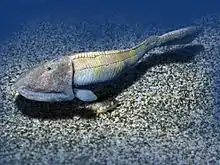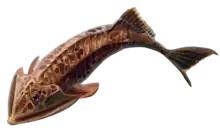Hemicyclaspis
Hemicyclaspis (lit. 'half-round shield' or 'semicircle plate') is an extinct genus of primitive jawless fish, closely related to Cephalaspis, that lived in the Late Silurian (Pridoli)[1] to Devonian period in what is now Europe and North America. A typical cephalaspid, Hemicyclaspis had a heavily armored, shovel-shaped headshield. It is thought to have been a better swimmer than most of its relatives because of its powerful tail, stabilizing dorsal fin and the keel-shaped hydrodynamic edges of its head shield. Hemicyclaspis probably foraged the ocean floor for food.[2]
| Hemicyclaspis Temporal range: | |
|---|---|
 | |
| H. murchisoni and Thyestes | |
| Scientific classification | |
| Domain: | Eukaryota |
| Kingdom: | Animalia |
| Phylum: | Chordata |
| Class: | †Osteostraci |
| Order: | †Atelaspidiformes |
| Family: | †Ateleaspididae |
| Genus: | †Hemicyclaspis |
Hemicyclaspis grew to a length of 5 inches (13 centimeters) and would most likely have fed on particles from the muddy sea bed.

Life reconstruction of Hemicyclaspis murchisoni
References
- Parker, Steve. Dinosaurus: the complete guide to dinosaurs. Firefly Books Inc, 2003. Pg. 58
- Blieck, Alain; Elliott, David K. (2017-06-01). "Pteraspidomorphs (Vertebrata), the Old Red Sandstone, and the special case of the Brecon Beacons National Park, Wales, U.K." Proceedings of the Geologists' Association. 128 (3): 438–446. doi:10.1016/j.pgeola.2016.07.003. ISSN 0016-7878.
- Palmer, D., ed. (1999). The Marshall Illustrated Encyclopedia of Dinosaurs and Prehistoric Animals. London: Marshall Editions. p. 25. ISBN 1-84028-152-9.
This article is issued from Wikipedia. The text is licensed under Creative Commons - Attribution - Sharealike. Additional terms may apply for the media files.
